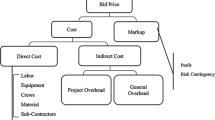Abstract
The AASHTOWare Pavement ME Design program is a pavement analysis tool, which is typically used for design purposes through an iterative trial-and-error process. To help the designer with a reasonable starting point in this iterative process, this paper introduces a machine learning method to embrace the recently updated models in AASHTOWare Pavement ME Design software for pavement design. A total number of 79,600 pavement design scenarios (55,800 for flexible pavements and 23,800 for rigid pavements) were performed using the AASHTOWare Pavement ME Design software to consider various design inputs, such as: design life, traffic volume, climate zone, thickness, and modulus of pavement layers. The inputs and outputs of these design scenarios were used to develop the multioutput Random Forests model to simultaneously predict multiple pavement distresses and thicknesses of pavement layers. The results indicate that the multi-output Random Forests model can accurately predict pavement distresses and thicknesses for asphalt and concrete pavements. This tool will simplify pavement design procedure based on the models in the AASHTOWare Pavement ME Design software.
Similar content being viewed by others
References
Aguiar GJ, Santana EJ, Mastelini SM, Mantovani RG, Jr SB (2019) Towards meta-learning for multi-target regression problems. arXiv: 1907.11277v1, DOI: https://doi.org/10.48550/arXiv.1907.11277
American Association of State Highway and Transportation Officials (AASHTO) (1993) Guide for design of pavement structures — 1993. National Cooperative Highway Research Program (NCHRP), Washington, DC, USA
American Association of State Highway and Transportation Officials (AASHTO) (2015) Mechanistic-empirical pavement design guide (A manual of practice). Washington, DC, USA
Applied Research Associates Inc. (ARA) (2004) Guide for mechanistic-empirical design of new and rehabilitated pavement structures. NCHRP 1–37A, National Cooperative Highway Research Program (NCHRP), Washington, DC, USA
Asphalt Institute (AI) (2020) US State binder specifications, Retrieved February 15, 2020, http://www.asphaltinstitute.org/engineering/specification-databases/us-state-binder-specifications/
Borchani H, Varando G, Bielza C, Larrañaga P (2015) A survey on multi-output regression. Wiley Interdisciplinary Review: Data Mining and Knowledge Discovery. 5(5):216–233, DOI: https://doi.org/10.1002/widm.1157
Federal Highway Administration (FHWA) (2017) Highway materials engineering course. Model E — Mechanistic-empirical design. Washington, DC, USA
Gong H, Sun Y, Hu W, Polaczyk P, Huang B (2019) Investigating impacts of asphalt mixture properties on pavement performance using LTPP data through random forests. Construction and Building Materials 204:203–212
Gong H, Sun Y Shu X, Huang B (2018) Use of random forests regression for predicting IRI of asphalt pavements. Construction and Building Materials 189:890–897
González C, Mira J, Ojeda JA (2016) Applying multi-output random forest models to electricity price forecast. Preprints, DOI: https://doi.org/10.20944/PREPRINTS201609.0053.V1
Graves RC (2012) An Innovative approach to mechanistic empirical pavement design. PhD Thesis. University of Kentucky, Lexington, KY, USA
Graves RC, Mahboub KC (2012) Streamlining use of mechanistic-empirical pavement design guide. Transportation Research Record: Journal of the Transportation Research Board 2305(1):170–176, DOI: https://doi.org/10.3141/2305-18
Hoffman K, Sung JY, Zazzera A (2021) Multi-output random forest regression to emulate the earliest stages of planet formation. arXiv:2104.12845v1, DOI: https://doi.org/10.48550/arXiv.2104.12845
Iowa Statewide Urban Design and Specifications (Iowa SUDAS) (2021) Design manual. Iowa State University, Ames, IA, USA
Li J, Uhlmeyer JS, Mahoney JP, Muench ST (2011) Use of the 1993 AASHTO guide, MEPDG and Historical performance to update the WSDOT pavement design catalog. WA-RD 779.1, Washington State Department of Transportation, Tumwater, Washington, Washington DC, USA
Linusson H (2013) Multi-output random forests. University of Boras (Högskolan I Borás), VT 2013: MAGI04
Ohio Department of Transportation (ODOT) (2015) Pavement design manual. Columbus, OH, USA
Pavement Guide Interactive (PGI) (2003) Pavement tools consortium (PTC), Washington state department of transportation (WSDOT) Pavement Guide, University of Washington, Seattle, Washington. http://training.ce.washington.edu/WSDOT/Modules/02_pavement_types/02-5_body.htm#joints
Santana EJ, Santos FR, Mastelini SM, Melquiades FL, Jr SB (2020) Improved prediction of soil properties with multi-target stacked generalisation on EDXRF Spectra. arXiv:2002.04312v1, DOI: https://doi.org/10.48550/arXiv.2002.04312
Schwartz CW, Carvalho RL (2007) Implementation of the NCHRP 1–37A design guide, Volume 2: Evaluation of mechanistic-empirical design procedure. MDSHA Project No. SP0077B41, The University of Maryland, College Park, MD
Schwartz CW, Li R, Kim SH, Ceylan H, Gopalakrishnan K (2011) Sensitivity evaluation of MEPDG performance prediction. NCHRP 1–47. Washington, DC: The National Academies Press
Wu Z, Groeger JL, Simpson AL, Hicks GR (2010) Performance evaluation of various rehabilitation and preservation treatments. FHWA-HIF-10-020. Federal Highway Management, Washington, DC.
Xi X, Sheng VS, Sun B, Wang L, Hu F (2018) An empirical comparison on multi-target regression learning. CMC-Computers, Materials & Continua 56(2):185–198, DOI: https://doi.org/10.3970/cmc.2018.03694
Xu D, Shi Y, Tsang IW, Ong YS, Gong C, Shen X (2019) A survey on multi-output learning. arXiv:1901.00248, DOI: https://doi.org/10.48550/arXiv.1901.00248
Yang G, Yu W, Li Q, Wang K, Peng Y, Zhang A (2019) Random forest-based pavement surface friction prediction using high-resolution 3d image data. Journal of Testing and Evaluation, DOI: https://doi.org/10.1520/JTE20180937
Zhang Z, Leidy JP, Kawa I, Hudson WR (2000) Impact of changing traffic characteristics and environmental conditions on flexible pavement. Transportation Research Record: Journal of the Transportation Research Board, No. 1730, Washington, DC, 125–131
Author information
Authors and Affiliations
Corresponding author
Rights and permissions
About this article
Cite this article
Yang, G., Mahboub, K.C., Renfro, R.L. et al. A Machine Learning Tool for Pavement Design and Analysis. KSCE J Civ Eng 27, 207–217 (2023). https://doi.org/10.1007/s12205-022-0448-z
Received:
Accepted:
Published:
Issue Date:
DOI: https://doi.org/10.1007/s12205-022-0448-z




